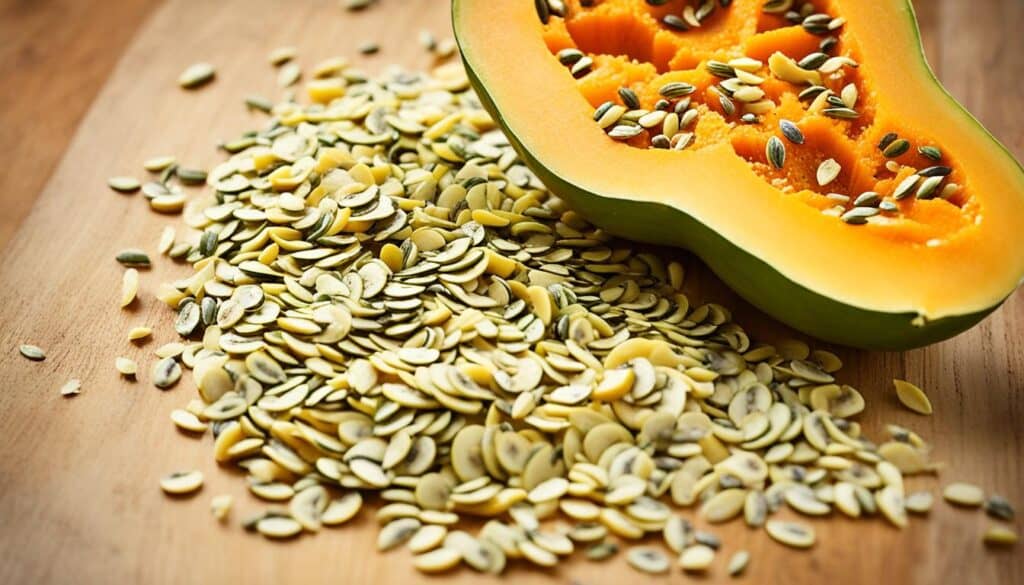Did you know that calabaza squash is not only delicious but also versatile and packed with nutrients? Whether you’re a seasoned chef or a home cook looking to try something new, join me on a culinary journey as we explore the different types of calabaza squash, learn how to cook it, discover delicious recipes, and explore its many benefits. Get ready to savor the delights of calabaza squash in all its forms!
Key Takeaways:
- Calabaza squash is a versatile and flavorful ingredient that can add a unique touch to your meals.
- It is rich in vitamins A, C, and E, as well as minerals like magnesium and potassium.
- There are different types of calabaza squash, each with its own unique flavor and texture.
- Cooking calabaza squash is simple and rewarding, with endless possibilities for roasting, sautéing, mashing, and more.
- There are countless delicious recipes that showcase the natural sweetness and creamy texture of calabaza squash.
The Health Benefits of Calabaza Squash
Calabaza squash is not only delicious but also packed with nutrients. Incorporating calabaza squash into your diet can provide you with numerous health benefits. Let’s explore the nutritional value and benefits of calabaza squash:
Nutritional Value of Calabaza Squash
Calabaza squash is a rich source of vitamins A, C, and E, which are essential for healthy eyesight, a strong immune system, and glowing skin. These vitamins act as antioxidants, protecting your body against cell damage caused by free radicals. Additionally, calabaza squash contains minerals like magnesium and potassium, which support various bodily functions such as nerve function, muscle contraction, and maintaining a healthy heart rhythm.
| Nutrient | Amount per 100g |
|---|---|
| Vitamin A | 5100 IU |
| Vitamin C | 11 mg |
| Vitamin E | 1.06 mg |
| Magnesium | 28 mg |
| Potassium | 340 mg |
In addition to vitamins and minerals, calabaza squash is also high in fiber, which aids in digestion and promotes a healthy digestive system. Fiber helps regulate bowel movements, prevents constipation, and supports overall digestive health.
Health Benefits of Calabaza Squash
By including calabaza squash in your meals, you can enjoy the following health benefits:
- Boosted Immunity: The vitamin C content in calabaza squash helps strengthen your immune system, protecting your body against infections and illnesses.
- Improved Eye Health: The high vitamin A content supports good eyesight and may reduce the risk of age-related macular degeneration and cataracts.
- Healthy Skin: Vitamins A and E in calabaza squash contribute to healthy skin by promoting collagen production, reducing fine lines and wrinkles, and protecting against sun damage.
- Heart Health: The potassium content in calabaza squash plays a role in maintaining a healthy heart rhythm and blood pressure.
- Weight Management: The fiber content in calabaza squash promotes feelings of fullness and aids in weight management by reducing overeating and controlling cravings.
With its nutrient-rich profile, calabaza squash is a delicious and healthy addition to your diet. Let’s explore the different types of calabaza squash in the next section and discover their unique flavors and uses.
Exploring Different Types of Calabaza Squash
Calabaza squash comes in various types, each with its own unique flavor and texture. Let’s take a closer look at the different varieties:
The Green Calabaza
The green calabaza is characterized by its mild and sweet taste. Its flesh is tender and has a subtle flavor that pairs well with a variety of dishes. This type of calabaza squash is great for soups, stews, and roasted vegetable medleys.
The Red or Orange Calabaza
The red or orange variety of calabaza squash is sweeter and more flavorful than the green type. Its vibrant color adds a pop of visual appeal to any dish. This type of calabaza squash is perfect for baking, pureeing, and incorporating into desserts like pies and cakes.
The Tan Calabaza
The tan calabaza has a distinct nutty flavor and a creamy texture. Its flesh is dense and holds its shape well when cooked. This type of calabaza squash is ideal for mashing, roasting, and using as a filling for savory dishes like empanadas or stuffed peppers.
By experimenting with different types of calabaza squash, you can explore a wide range of culinary possibilities and discover your favorite flavors. Whether you prefer the mildness of the green variety, the sweetness of the red or orange variety, or the nuttiness of the tan variety, calabaza squash is sure to add a unique touch to your recipes.
| Type of Calabaza Squash | Flavor | Texture |
|---|---|---|
| Green Calabaza | Mild and sweet | Tender |
| Red or Orange Calabaza | Sweet and flavorful | Soft |
| Tan Calabaza | Nutty | Creamy |
How to Cook Calabaza Squash
Cooking calabaza squash is simple and rewarding. It can be prepared in various ways to create delicious and versatile dishes that will delight your taste buds. Here are a few cooking methods that will bring out the best flavors of calabaza squash:
- Roasting: Start by preheating your oven to 400°F (200°C). Cut the calabaza squash into small cubes and toss it with olive oil, salt, and your favorite spices, such as cumin or paprika. Spread the cubes onto a baking sheet and roast for about 30 minutes, or until the squash is tender and golden brown. Roasting intensifies the natural sweetness of the squash and adds a hint of caramelization.
- Sautéing: Heat a tablespoon of oil or butter in a skillet over medium heat. Add the sliced or diced calabaza squash and sauté for about 10-12 minutes, until it becomes tender and slightly browned. You can enhance the flavors by adding garlic, onions, or herbs like rosemary or thyme.
- Mashing: Steam or boil the calabaza squash until it is soft and easily mashed with a fork. Drain the cooked squash and transfer it to a bowl. Add a knob of butter, a splash of milk, and your desired seasonings, such as nutmeg or cinnamon. Mash everything together until smooth and creamy. This method creates a velvety side dish that pairs well with roasted meats or poultry.
- Soups and Stews: Calabaza squash adds a rich and creamy texture to soups and stews. Simply chop the squash into small pieces and simmer it in broth or stock along with other vegetables, like carrots, onions, and celery. Season with your favorite herbs and spices, and let it cook until the squash is tender. Puree the mixture with a blender or an immersion blender to achieve a smooth and hearty consistency.
Feel free to experiment with different cooking methods and flavor combinations to create unique dishes that suit your taste. Whether you prefer the crispy sweetness of roasted calabaza squash or the comforting warmth of a creamy soup, calabaza squash offers endless possibilities to elevate your culinary creations.
Delicious Calabaza Squash Recipes
Looking for new and exciting ways to enjoy calabaza squash? Look no further! I’m excited to share some delectable calabaza squash recipes that will tantalize your taste buds. Whether you’re craving a comforting soup, a spicy curry, or a flavorful taco, calabaza squash has got you covered. Let’s dive in and explore these mouthwatering recipes that highlight the natural sweetness and creamy texture of calabaza squash.
1. Calabaza Squash Soup
If you’re a fan of comforting soups, this calabaza squash soup is a must-try. The velvety texture and rich flavor of the squash blend perfectly with aromatic herbs and spices. Serve it as an appetizer or a satisfying main course.
2. Calabaza Squash Curry
Spice up your dinner with a flavorful calabaza squash curry. The combination of fragrant spices, creamy coconut milk, and tender squash creates a tantalizing dish that will transport you to the exotic flavors of the East.
3. Calabaza Squash Tacos
Elevate your taco game with these mouthwatering calabaza squash tacos. The roasted squash adds a delightful sweetness and creamy texture to the savory taco fillings. Top it off with your favorite toppings and salsa for a burst of flavors.
4. Calabaza Squash Risotto
Indulge in the creamy and comforting goodness of calabaza squash risotto. The tender squash blends beautifully with the creamy risotto, creating a luxurious dish that will impress your dinner guests. Add some Parmesan cheese for an extra touch of decadence.
5. Calabaza Squash Pie
For dessert lovers, this calabaza squash pie is a delightful treat. The smooth and subtly sweet filling, spiced with cinnamon and nutmeg, is encased in a flaky crust. Serve it warm with a dollop of whipped cream for the perfect ending to a delicious meal.
6. Calabaza Squash Bread
Bake a loaf of fragrant calabaza squash bread and fill your home with the irresistible aroma of freshly baked goods. This moist and flavorful bread is perfect for breakfast or as a tasty snack throughout the day. Spread some butter or your favorite jam for a delightful treat.
These are just a few examples of the endless possibilities that calabaza squash offers. Feel free to experiment and get creative in the kitchen to create your own unique calabaza squash dishes. Remember, the natural sweetness and creamy texture of calabaza squash make it a versatile ingredient that can shine in both savory and sweet recipes. So, gather your ingredients and get ready to savor the deliciousness of calabaza squash!
Growing and Harvesting Calabaza Squash
If you have a garden or a desire to grow your own calabaza squash, you’ll be pleased to know that it’s relatively easy to do so. Calabaza squash thrives in warm climates and requires full sun and well-draining soil. It can be grown from seeds or seedlings and should be planted after the danger of frost has passed. As for harvesting, calabaza squash is ready to be harvested when the skin is hard and the stem is dry. Simply cut the squash from the vine, leaving a few inches of stem attached, and it’s ready to be enjoyed.
Calabaza Squash Dishes from Around the World
Calabaza squash is a versatile ingredient that is widely used in various cuisines around the world. Its unique flavor and creamy texture make it a favorite in many traditional dishes. By exploring calabaza squash dishes from different cultures, you can expand your culinary repertoire and discover new flavors.
Latin America
In Latin America, calabaza squash is a staple in many dishes. One popular preparation is calabaza soup, a comforting and flavorful dish that showcases the natural sweetness of the squash. Stuffed calabaza squash is another traditional recipe, where the squash is hollowed out and filled with a savory mixture of meat, vegetables, and spices. Calabaza empanadas, a type of pastry filled with a delicious calabaza squash filling, are also a favorite.
The Caribbean
In the Caribbean, calabaza squash is often used in stews and curries. The squash’s creamy texture and mild flavor complement the rich and spicy Caribbean spices. Calabaza squash is also commonly used in soups and side dishes, adding a hearty element to the meal.
Asia
In Asian cuisines, calabaza squash is primarily used in stir-fries and noodle dishes. Its firm texture holds up well to high heat and absorbs the bold flavors of Asian seasonings. Whether added to a colorful stir-fry or tossed with noodles, calabaza squash adds a unique twist to Asian-inspired meals.
United States
In the United States, calabaza squash is a popular ingredient in Thanksgiving pies. Its smooth and creamy consistency makes it the perfect base for a delicious pumpkin or calabaza pie. The natural sweetness of the squash pairs beautifully with warm spices like cinnamon, nutmeg, and ginger.
By exploring calabaza squash dishes from different cultures, you can embrace a world of flavors and create exciting and delicious meals. Whether you’re enjoying a comforting calabaza soup from Latin America or savoring a fragrant calabaza curry from the Caribbean, calabaza squash adds a unique and delightful touch to any dish.
| Region | Calabaza Squash Dish |
|---|---|
| Latin America | Calabaza Soup |
| Latin America | Stuffed Calabaza Squash |
| Latin America | Calabaza Empanadas |
| The Caribbean | Calabaza Stew |
| The Caribbean | Calabaza Curry |
| Asia | Calabaza Stir-Fry |
| Asia | Calabaza Noodle Dish |
| United States | Calabaza Pie |
The Versatility of Calabaza Squash
One of the great things about calabaza squash is its versatility in the kitchen. It can be used in both savory and sweet dishes, and its creamy texture and natural sweetness make it a great substitute for other ingredients.
For example, you can use mashed calabaza squash as a healthier alternative to mashed potatoes or use it as a filling for tacos or enchiladas. Calabaza squash can also be used in baking, adding moisture and flavor to breads, muffins, and desserts. Its versatility opens up a world of culinary possibilities.
Discover the diverse ways you can incorporate calabaza squash into your cooking:
Savory Dishes
- Roasted calabaza squash cubes as a side dish or salad topping
- Sautéed calabaza squash as a flavorful vegetable side
- Calabaza squash soup for a comforting meal
- Calabaza squash curry for a spicy and aromatic dish
Sweet Treats
- Calabaza squash pie with a flaky crust and a hint of cinnamon
- Calabaza squash bread, moist and fragrant
- Calabaza squash muffins, perfect for breakfast or a snack
- Calabaza squash pudding, creamy and indulgent
As you can see, the possibilities are endless! Let your creativity shine in the kitchen and explore the versatility of calabaza squash.
Enjoy the nutritious goodness and delicious flavors that calabaza squash brings to your meals.
Calabaza Squash and Its Nutritional Value
Calabaza squash is not only delicious but also nutritious. It is packed with essential vitamins and minerals that are beneficial for your overall health. Let’s explore the nutritional value of calabaza squash:
Vitamins:
Calabaza squash is a rich source of vitamins A, C, and E. Vitamin A promotes healthy eyesight, while vitamins C and E support a strong immune system and contribute to glowing skin.
Minerals:
In addition to vitamins, calabaza squash contains important minerals like potassium and magnesium. Potassium helps maintain proper heart function, while magnesium is essential for muscle and nerve function.
Dietary Fiber:
Calabaza squash is also a good source of dietary fiber, which plays a crucial role in promoting a healthy digestive system. Fiber aids in digestion and helps prevent constipation.
By incorporating calabaza squash into your meals, you can enjoy its nutritional benefits and nourish your body.
Tips for Selecting and Storing Calabaza Squash
When it comes to selecting the perfect calabaza squash, there are a few things to keep in mind. Look for squash that is firm to the touch and feels heavy for its size. Avoid any squash that has soft spots or blemishes, as this may indicate that it is past its prime. The skin of the squash should be matte and free from cracks. By choosing the freshest calabaza squash, you can ensure that it will have the best flavor and texture in your recipes.
Proper storage is key to keeping your calabaza squash fresh and delicious. Store the squash in a cool, dark place, such as a pantry or cellar, to extend its shelf life. Avoid storing it in direct sunlight or near sources of heat, as this can cause it to spoil more quickly. If you have a cut or cooked calabaza squash, it’s best to store it in an airtight container in the refrigerator. This will help prevent any bacterial growth and keep it fresh for up to a week.
Embracing the Flavors of Calabaza Squash
Calabaza squash offers a unique flavor profile that is both sweet and nutty. Its natural sweetness pairs well with savory ingredients, herbs, and spices, while its creamy texture adds depth and richness to dishes. By embracing the flavors of calabaza squash, you can create delicious and satisfying meals that will delight your taste buds.
Whether you’re roasting calabaza squash with aromatic spices or incorporating it into a hearty stew, its distinct flavor will truly elevate your culinary creations. Not only does it add a delightful sweetness, but it also imparts a subtle nuttiness that enhances the overall taste of the dish.
One of my favorite ways to embrace the flavors of calabaza squash is by using it in a comforting soup. The creamy texture of the squash lends itself perfectly to a velvety soup that is both satisfying and flavorful. Whether you’re blending it with warming spices like cinnamon and nutmeg for a fall-inspired soup or infusing it with fragrant herbs like thyme and rosemary, you can create a soup that will warm your soul.
Delicious Calabaza Squash Soup Recipe
“This calabaza squash soup is a true celebration of the flavors of fall. With its creamy texture and aromatic spices, this soup is sure to impress.”
Ingredients:
- 1 medium calabaza squash
- 2 tablespoons olive oil
- 1 onion, diced
- 2 cloves of garlic, minced
- 1 teaspoon ground cumin
- 1/2 teaspoon ground cinnamon
- 4 cups vegetable broth
- Salt and pepper to taste
Instructions:
- Preheat your oven to 400°F (200°C). Cut the calabaza squash in half and remove the seeds. Place the squash halves on a baking sheet and drizzle with olive oil. Roast in the oven for about 45 minutes, or until the squash is tender.
- While the squash is roasting, heat the olive oil in a large pot over medium heat. Add the diced onion and minced garlic, and sauté until the onion is translucent.
- Add the ground cumin and ground cinnamon to the pot and cook for another minute to toast the spices.
- Once the squash is roasted, scoop out the flesh and add it to the pot. Stir well to combine with the onion, garlic, and spices.
- Pour in the vegetable broth and bring the soup to a simmer. Let it cook for 10-15 minutes to allow the flavors to meld together.
- Using an immersion blender or regular blender, carefully blend the soup until smooth and creamy.
- Season with salt and pepper to taste. Serve hot and enjoy!
This delightful soup is just one example of how you can embrace the flavors of calabaza squash. Whether you’re using it in a curry, risotto, or even as a filling for empanadas, this versatile ingredient will add a touch of sweetness and richness to your dishes.
So, don’t be afraid to experiment and get creative with calabaza squash in your cooking. Explore different flavor combinations, try out new recipes, and let the unique flavors of calabaza squash take center stage in your culinary adventures.
Conclusion
Calabaza squash is a versatile and delicious ingredient that can elevate your culinary creations. Its unique flavor profile, combining sweetness and nuttiness, makes it a perfect addition to both savory and sweet dishes. From soups and stews to pies and breads, the possibilities are endless when it comes to incorporating calabaza squash into your meals.
Not only is calabaza squash a flavorful ingredient, but it also offers numerous health benefits. Packed with essential vitamins and minerals, including vitamins A, C, and E, as well as potassium and magnesium, calabaza squash nourishes your body while tantalizing your taste buds. Its high fiber content promotes a healthy digestive system, making it a nutritious choice for your meals.
Whether you’re a seasoned chef or a home cook looking to try something new, calabaza squash is the perfect ingredient to experiment with. With its creamy texture and natural sweetness, it can be used as a substitute for other ingredients or take center stage in your dishes. So, don’t hesitate to embark on a culinary journey and savor the delights of calabaza squash in all its forms. Happy cooking!










Leave a Reply